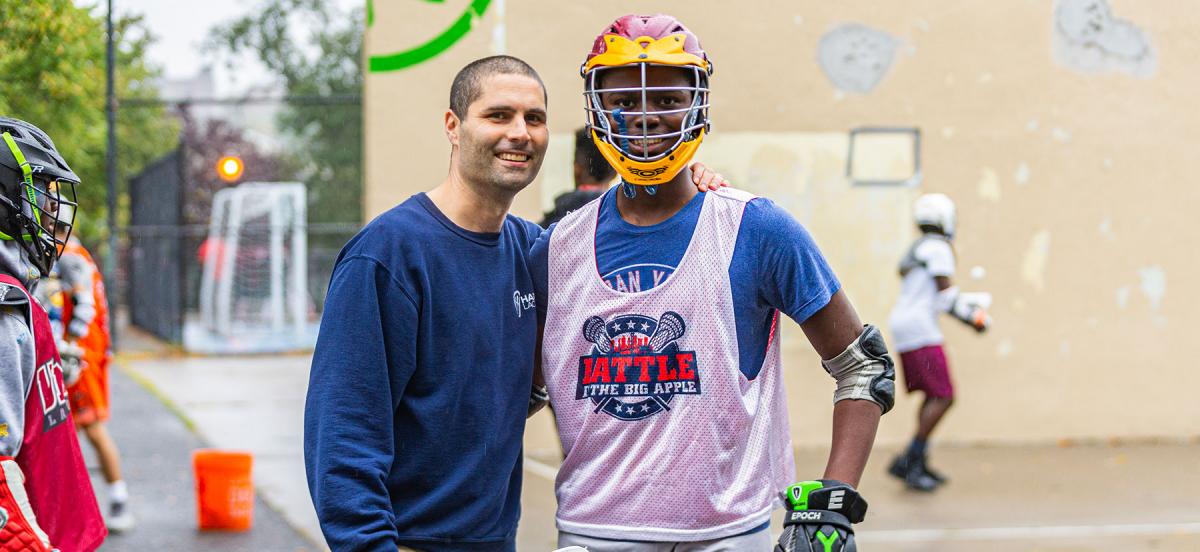Heads in the Game

Joel Censer '08 coaches a student on one of the handball courts Harlem Lacrosse uses for practices. Photo by Patrick Montero.
Details
Harlem Lacrosse puts coaches in schools to help at-risk students achieve. The skills and lessons taught by team sports, says Joel Censer ’08, “couldn’t be more transferable.”
If you click on the website for the nonprofit sports-based Harlem Lacrosse—where Joel Censer ’08 is now chief program officer after starting out as a coach—you’ll notice something quirky. The very last thing on the organization’s list of its supports for at-risk students is ... “lacrosse instruction.”
That’s by design according to Censer, who joined in 2013 as the second of two employees and watched Harlem Lacrosse expand outside of New York City to Boston, Los Angeles, Baltimore, and Philadelphia.
The goal is to have a lacrosse coach in schools all day to help students find success—both academic and in their everyday lives—by using the stick-and-ball team sport based on Native American games as the vehicle for helping kids “reach their full personal potential.” Graduates of Harlem Lacrosse have gone on to attend independent and boarding schools, and been accepted to colleges—including Haverford— receiving close to 40 million dollars in scholarship offers in the process.
Censer spoke to us about how his passion for lacrosse led him to become an all-American defenseman at Haverford and what it is about the sport that has a vital effect.
He wasn’t a natural-born lacrosse star. When I get my mind on something, I want to achieve at it. I was pretty bad initially, but I liked watching film and loved reading about lacrosse and watching it. I was in my basement, throwing a ball against the wall over and over with my stick. If lacrosse taught me anything it’s that getting good takes hours and hours of work.
Harlem Lacrosse is the perfect marriage of interests. Before I was hired, I was writing features at USLacrosse Magazine and working with a professor at George Mason who was researching best practices in juvenile justice. I was becoming interested in social justice issues in lacrosse, where there are real problems around equity and access. I had spent lots of time researching the history of the game and all that time learning and even reading lacrosse message boards helps me with what I do now. I wouldn’t have that knowledge if I didn’t have an interest in the community.
Coaches are more than a coach. The organization is built around the idea of the unique presence and power of a coach. It was started by a teacher in a New York City middle school who was struggling to connect with his special education class. One day, he brought the students to a nearby handball court and taught them lacrosse. The kids later had the highest test scores of any special education class in the history of the school.
The big thing about Harlem Lacrosse is there’s no barrier to entry—there are no cuts and no costs to be on the team. Anyone who wants to play can play, and parents don’t have to drive their kid to a field. But the requirement is that students have to attend study hall and be invested. The genius of it is the difference in investment. We’re paying for a hyper-localized coach working closely with the students all day and throughout the year. The program directors know things like what subjects the students are struggling in and the talk around school and are able to effectively act on it because lacrosse is a carrot for the student-athletes.
What makes lacrosse so special to these kids. It’s a fast-paced sport with a lot of action, and it helps that players aren’t usually standing around. But in this case, there’s something about traversing communities that’s interesting to kids. They love to meet people in different zip codes and be a part of something new. There are so many people involved in lacrosse who are willing to invest and build bridges between communities. The program also gives our participants an opportunity to reinvent themselves in ways they didn’t know they could.
Success in the sport translates to the classroom. If you can stand in line for 10 seconds and do the next rep in a drill, it helps you in your classes. Playing on a team provides social-emotional learning that’s critical. If you cheer on your teammate or lose a game and shake an opposing player’s hand, these are direct things you do in life if you fail. And you fail over and over in sports. You have to learn how to achieve again. These are skills and lessons that couldn’t be more transferable.
Students don’t need giant fields to learn the sport. New York has no space, but a lot of unused handball courts. Those are great places for training and skill development. It’s a lot like playing box lacrosse, an indoor version of the game with fewer players. That means they’re more active and they touch the ball more. There’s more teamwork, and the fastest, biggest, strongest player can’t run through everybody. You want to give all the kids skills and then teach them how to use them together and as a team. That’s how you create both more personal growth and a more equitable sports experience.



